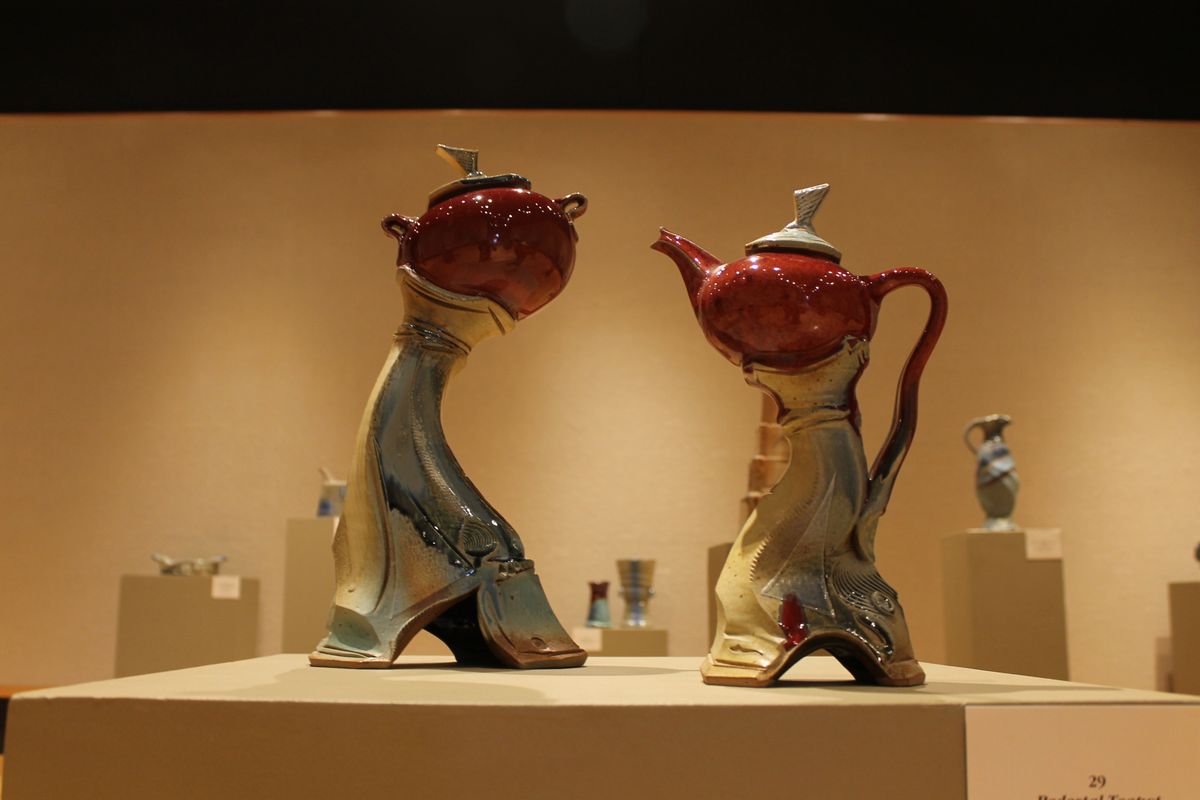Gallery shows a timeline of artistic skill and style

The Eide/Dalrymple Gallery’s current exhibit, “27 Years: Clay is the Way” Ceramics by Tony Winchester, is a timeline of Iowan professional potter Tony Winchester’s artwork over the past few decades. An engaging dive into ceramics, the gallery showcases the artist’s evolution of skill and a refinement of an experimental style.
According to the exhibit sign at the gallery’s entrance, Winchester has been working as a full-time studio artist since the early 1990s. Since his beginnings, he has used the pottery wheel as his main medium but has experimented with different approaches, such as faceting, or cutting, the clay.
One of Winchester’s oldest pieces on display is called “Vase” (designated as entry number two in the exhibit), which he created in 1993. The work is a stout, olive-brown vase that appears modest at first — the body of the piece is a typical vase.

At the foot, however, Winchester leaves excess clay so that it looks like the weight of the vase is folding in on itself. As a result, the base looks like flowing magma. This clashing of appearances makes the piece feel lively and in-motion, and it’s an idea he often returns to.
While Winchester’s artistic style is prevalent from the first pieces, the gallery shows how he has grown as an artist, both in ability and creativity.
Created in 2001, the 24th entry in the exhibit is “V Vase,” and while it shares a name with the earlier piece, that’s about all the two have in common.
A towering piece compared to the encased works, “V Vase” is reminiscent of classical decor due to its fanciful appearance. The vase is constructed of tall, angular slabs that twist as they descend, compress near the middle, then expand out at the base. The piece’s glaze, which is a stone-looking texture that mixes sky-blue with bronze, compliments the structure.
Building off the name of 1993’s “Vase,” “V Vase” similarly expands upon the experimental, distorted style of Winchester’s initial works.

Following “V Vase” by five years is “Pedestal Teapot.” The base of the piece is a tall, slender stand. While the podium consists of geometric angles, these sharp lines are softened by the way they shift and bend toward the bottom, giving off a melting feeling. The glaze of the pedestal is a mix of light blue and tan, which blend into each other.
Atop the stand is a crimson teapot. Unlike the base, the pot itself is gentle and smooth, and while the base has a more matte glaze, the pot’s is so sleek that it carries a reflection of the room.
The elegance of the teapot is in harsh contrast with the rigid podium it sits upon, but the two separate parts don’t feel disjointed. This is primarily due to the teapot’s handle, which starts at the pot itself but connects to the stand. With the handle’s color flowing from the deep red into the blue and tan, it serves as a physical bridge between the two styles.

“Pedestal Teapot” encapsulates the evolution of his style and skill that came from years of work presented in the exhibit.
Additionally, part of what makes this exhibit work so well is how the pieces are physically curated and laid out. Instead of a strictly chronological display, the gallery jumps between periods of Winchester’s work. Because of this, the viewer sees how Winchester’s artistic expression has stayed present in his work despite his evolution as a potter.
That being said, the layout can get confusing for someone who is trying to view the works in the timeline in which they were created. Doing so would involve running around the room, going from display to display.
As it is, though, 27 Years: Clay is the Way is still enjoyable and engaging. The exhibit is a beautiful presentation of Winchester’s years-long evolution of his skill and style as an artist, and students should experience it while they have the opportunity.“27 Years: Clay is the Way”: Ceramics by Tony Winchester runs until Dec. 10. The reception will take place Dec. 1 at 7 p.m.



